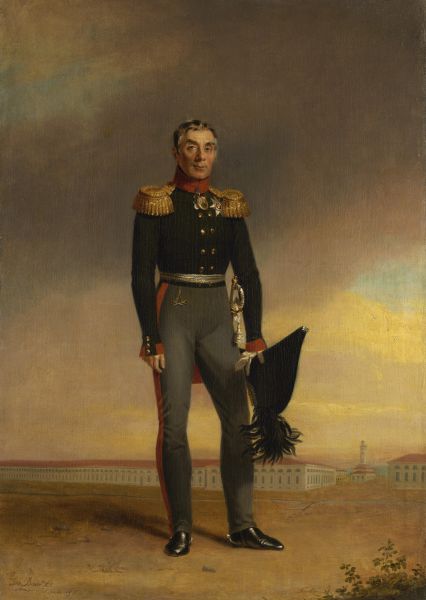|
|
Portrait of Count Alexei Arakcheyev

Dawe George
88 x 61
Annotation
Alexei Andreyevich Arakcheyev (1769–1834) was a Count. He studied at the Artillery Cadet Corps and in 1787 was made an officer. He was a favourite of the Grand Duke Paul Pavlovich. In 1796 he became major general, Commandant of St Petersburg.
He was made Baron (5 April 1797), Knight of the Order of St Alexander Nevsky (1797), and then Count (5 May 1799). His fall into disgrace took place from 1799 to 1808. Under the reign of Alexander I he became minister and Inspector General of all Infantry and Artillery. In the last decade of his rule Alexander I exerted unlimited influence over every area of Imperial rule. He was the author of the project (making plans, drawings, estimates) for military settlements, and the first barracks which were built on his estate in Gruzino served as a pattern for the building of similar barracks and other structures. From 1819 he was the head of military settlements. Following the accession of Nicholas I he retired and lived in the Gruzino estate, where he was buried in the Cathedral of St Andrew. He appears here in uniform against the background of the barracks of the military settlement in Gruzino. On his epaulettes is the monogram of Alexander I. On the neck ribbon of the Order of St Andrew is a silver medal “In Memory of the Patriotic War of 1812” and a medallion he was granted with a miniature portrait of Alexander I. On his chest is the Order of St Alexander Nevsky (star).
Author's Biography
Dawe George
Dawe, George Edward
1781, London – 1829, Kentish Town (near London)
English painter, draughtsman,portraitist. Son and student of engraver F. Dawe. Elder brother of engraver Henry Edward Dawe. Studied at the Royal Academy of Arts in London (1803). Academician (1813). Honorary member of the academies of arts of Vienna, Florence, Munich, Dresden, Stockholm and Paris. Moved to Russia on the invitation of Emperor Alexander I to paint portraits of commanders who fought in the Patriotic War of 1812. Together with his Russian assistances Alexander Polyakov and Vasily Golike created 322 portraits of Russian generals for the Military Gallery in the Winter Palace. Produced many paintings on commission. Honorary associate member of the Imperial Academy of Arts in St Petersburg (1820). First portrait painter of the Imperial Court (1828). Left St Petersburg (1828), returned for a short time (February 1829), then left for London via Warsaw.

